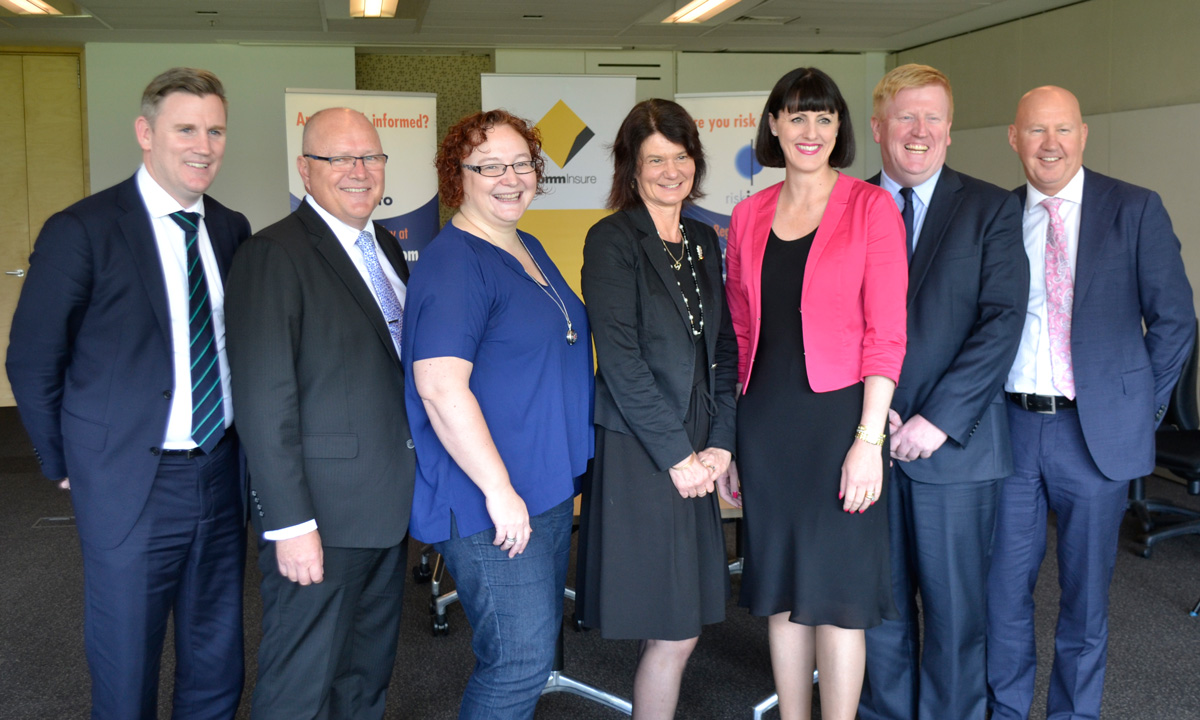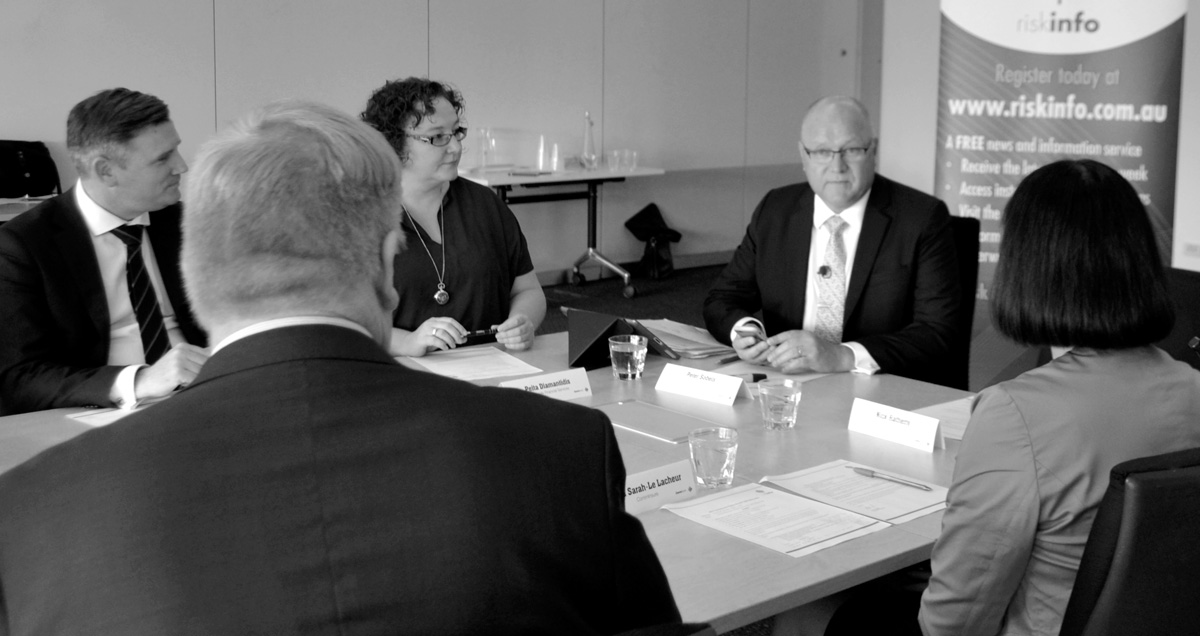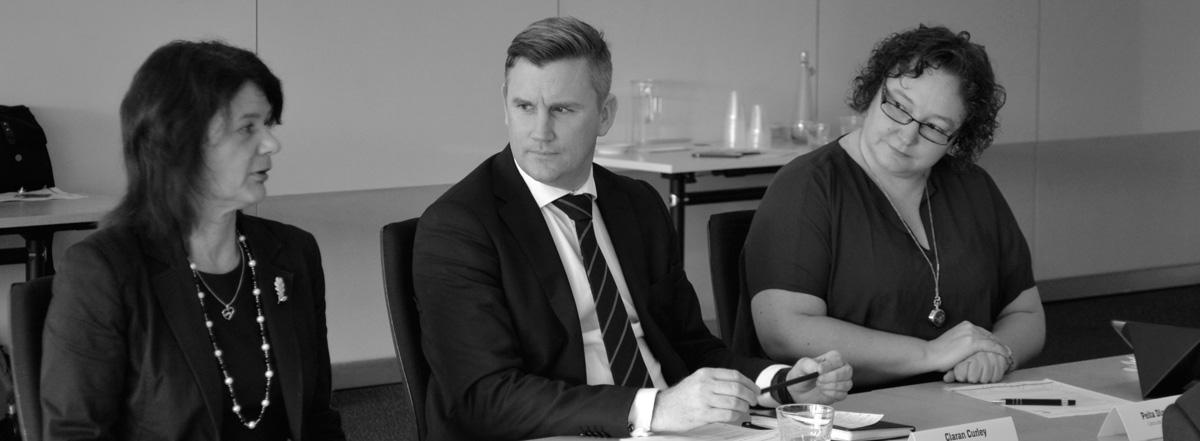Riskinfo joined forces with CommInsure to conduct a recent Round Table conversation during which a broad spectrum of claims-related issues was discussed – issues impacting life companies, advisers and their clients.
Table of contents (Click these links to move directly to those topics)
- Perception and reality
- CommInsure staff and adviser responses
- Advisers and claims
- The role of insurers
- Mental health
- Using technology to improve the claims experience
- Wrapping up
Given the critical role played by claims services and the current-day issues impacting this sector of the life insurance industry, this Round Table discussion demanded an honest, frank and open exchange of dialogue between our life company and adviser panellists.
To this end, we were grateful to CommInsure’s Olivia Sarah-Le Lacheur and Ciaran Curley for their willingness to discuss the issues raised by the media reporting during the first half of 2016.

Panelists (L – R)
- Ciaran Curley, Head Of Claims Strategy, CommInsure
- Peter Sobels, Publisher, Riskinfo
- Peita Diamantidis, Co-Founder & Senior Adviser, Caboodle Financial Services
- Diane Bleasdale, Senior Adviser, Bridges Financial Services
- Olivia Sarah-Le Lacheur, Head of Life Distribution, CommInsure
- Jason Spits, Senior Journalist, Riskinfo
- Nick Hatherly, Managing Director, AFRM
Perception and reality – Back to top
We asked Olivia and Ciaran to share their views on the allegations and criticisms that were directed towards CommInsure by the media and we were also keen to understand the impact this controversy had on the management and staff within CommInsure and on advisers and their clients.
Looking back to the first half of 2016 we started by asking Ciaran his view on which of the media criticisms were fair and which were not:
“There’s no question about it that we can do things better and we should have done things better, particularly with respect to our definition of heart attack, which we acknowledge was out of step with what the community would expect,” said Ciaran. “So we’ve rectified this and have passed back that definitional change now to October 2012, which is a great thing for our customers,” he added.
Ciaran also noted that this provided CommInsure with “…a good opportunity to critically examine our processes and procedures to identify where we can improve and how we can engage better with customers and advisers when they need our support most.”
“It was a really difficult period for us, as an organisation and I think the independent expert Deloitte report that was recently released, and the ASIC investigation into CommInsure reassured us of what we already knew about our business, that it is an ethical business and our people operate with integrity.”
trust in a relationship with you guys is the most important thing we have
Ciaran told the panel that, after assessing all of the work that was completed, there is nothing to support the allegation that CommInsure engaged in ‘doctor shopping’ for the purpose of securing preferred medical opinions in relation to claims, and nothing to support allegations with respect to an increase in surveillance practices. He said claims case managers are not financially rewarded for declining claims.
“This isn’t a set and forget approach for us,” continued Ciaran. “…the declined claims review was the largest across the industry and focussed on the end-to-end customer experience in addition to the quality of decision making. We are 100% committed to improving the claims experience and there’s a program in place to make sure that, as a business, we continually look to evolve and improve.”
CommInsure’s Head of Life Distribution, Olivia Sarah-Le Lacheur, shifted the emphasis of the conversation by asking the panel to consider the insurance claim process from the perspective of the claimant. Referring to the self-analysis that has occurred within CommInsure following the 2016 media allegations, Olivia said “… one thing that’s become evident is the timeliness of communications. So, what we’ve stared into quite deeply at CommInsure was what it really feels like when you’re the person who is submitting a claim.”

Olivia explained, “We might have a process that takes a defined period of time, and it makes very logical sense to us, but when you’re the person who is having the claim event happen to you, you’re in a very emotional state, and usually you’re involved in something you’ve never done before, which is talking to a life insurance company about the forms you need to complete, the reports that need to be obtained, and to go through a process that’s unfamiliar.
“So, if I think about the advisers and the licensees that we deal with, one of the emerging conversations out of last year’s media coverage is, what role can I play as an adviser or licensee in identifying our value proposition around the claims experience?
“For my distribution team, one of the conversations we had very early on was, what do you think your involvement should be in the claims process? What came back very strongly, for us, was that relationships are at the heartbeat of the insurance business, whether it’s a relationship between the adviser and Ciaran’s claims team, or whether it’s the relationship between the adviser and the client. When people talk to each other you get much better outcomes because you can make things clearer, easier to understand, and make them very relevant and specific to the individual. So, what we’ve seen is licensees, who previously didn’t have a licensee standard around the claims engagement, are starting to articulate that in writing and are saying to their advisers, ‘This is an expectation we have if you’re part of our group. Now we want you to look at what you’re going to do in your own practice.’”
Olivia shared with the panel that another element that was very important for CommInsure last year was the concern amongst the adviser community about the allegations raised in the media. “They wanted clarification and they wanted confidence so that they could pass it on to their clients, because our brands are intermingled – the insurer’s brand, the adviser’s brand, and they connect together for the customer. So, as soon as there was any media coverage at all we made a conscious decision that we would proactively reach out to as many advisers as we could to ask them how they were feeling, what they were worried about and what information could be shared to help them retain or restore their confidence in CommInsure.”
The three adviser panellists at our Round Table were asked how they responded to the media reports on CommInsure from the first half of last year and whether this had any impact on their clients.
Peita Diamantidis said her advice business experienced “…an inundation of calls. We even had some clients cancel their policies, so it was that extreme. We were doing a lot to mitigate that because I just don’t believe trial by media is a way to get anything done.” Peita told her peers that “…the actions that big corporates must take after something like this happens is more about perception than it is about reality. I’d prefer to see some sweeping underground change for the industry; not something that’s just reacting to the moment.”
Why is there any paperwork? Why isn’t it all electronic?
Peita said she was more interested in changes that are long standing and fundamental. “So, I’m interested in how we can change how hard it is for clients to claim and why there is any paperwork. Why is there any paperwork? Why isn’t it all electronic?” she asked; her point being that a totally electronic claims process would help to fundamentally change the claimant experience and help to move it away from being a sometimes traumatic experience.
“I don’t think there’s ever been a time where the public has been more sceptical of institutions,” said Peita. Questioned as to whether she believes this consumer attitude is replicated in other countries, she said “I think it’s a financial industry thing, unfortunately, and generational. So, I think, Gen X and particularly Gen Y have a massive distrust of institutions, and in particular, financial ones. So, I think, unfortunately, these issues are hitting a market that isn’t ready to say, ‘You guys are the good guys and we know this is an issue, but we believe you’ll get through it.’ They’re like, ‘Hold on, I’m just never quite sure what you guys are about anyway, and now look what happened.’ So, I think just the angle they come from before they even hear the facts is quite different than it used to be,” she concluded.
Diane Bleasdale, a senior risk-focused financial adviser from Bridges Financial Services, said her first impression of the 2016 media reports was that it wasn’t fair to CommInsure “… because our experience of claims, with CommInsure, had been very good.” Diane noted CommInsure had recently “…gone outside the box and paid additional benefits to clients.” She said she was surprised when CommInsure twice paid a critical illness benefit in an income protection policy claim because the client didn’t take any sick leave the first time they had cancer, but when he actually did take sick leave it was 18 months later. “…and because it was over 12 months, they paid it again. It was astounding, I couldn’t believe it,” she said.
Unlike Peita, Diane told the panel she did not get questioned by her clients who held CommInsure policies. “…they just checked that their policies were okay.” Diane added, however, that she was contacted by non-CommInsure policyholder clients asking whether their insurance was okay. “So, we were reassuring clients who weren’t with CommInsure more than we were reassuring clients with CommInsure, which I found quite interesting,” she said.
Offering his own take on the 2016 CommInsure media allegations, Australian Financial Risk Management’s MD, Nick Hatherly, made a very pointed observation. Referring to the age of some of the policies that were the subject of the media reports and the fact that no advisers appeared to be involved, Nick commented: “Unadvised claims are a nightmare. Who was acting for that person?” Nick told the panel he thinks all insurers get it wrong: “…you want to build relationships with claimants, but that’s not your job. There should be somebody sitting in the middle who builds that relationship with the trust, and that’s the adviser. It has always been the adviser, [but] unfortunately not all advisers manage this process well.”
CommInsure staff and adviser responses – Back to top
Ciaran and Olivia were asked about the mood inside CommInsure during the height of the controversy. Ciaran: “It was an incredibly difficult time for people working in the CommInsure business.” Referring in particular to the environment within CommInsure’s claims area, Ciaran said “I have to say, and Diane mentioned it, the support we received from financial advisers was absolutely fantastic. Many personally made a point of contacting us. We heard stories of advisers speaking at conferences describing their experiences with our claims team vastly different to what had been reported in the media. You really need moments like this to help you through difficult times,” said Ciaran.
Ciaran continued, “…as difficult as it was for individuals within the business I’m very proud of how we focussed our attention on the customer. We provide support to customers with serious illnesses, support customers that have lost a loved one or can no longer work due to a disability. Having that perspective tells you that these customers are in a far worse position. So, in effect, this is how we navigated through the difficult times.
“What I’d like to think is that for those advisers who were critical it was more on a perception basis. Maybe they hadn’t had a claims experience with us. So, absolutely, there was some criticism [from advisers] and you can understand why, [but] as I said, I’m very proud of the business in terms of how we navigated through that.”
Olivia added the she and her support team continue to speak with advisers and licensees every day “…and what we saw was people always react differently to anything that is quick, shocking or unexpected. Some people look for logic and others need to work through an emotional response. We did have several advisers calling or emailing very upset about the media coverage and wanting to work through that in their own way.”

Olivia told the panel her aim and that of her CommInsure colleagues, was to make themselves both visible and available so they could work through the issues with advisers. She said the fundamental concern held by advisers was the same as it was for CommInsure staff: “Our integrity was being questioned,” Olivia continued, “…so, our focus was to be visible and active in those conversations, and work through as best we could what advisers needed to reach a position of comfort and clarity.” She conceded CommInsure didn’t achieve that outcome with every adviser, and that there are some who will always have residual questions, “…but we felt that being open and transparent was the best way to deal with it.”
Nick also suggested some claims are declined on legally valid reasons but sometimes may not pass a ‘moral’ test. He told the panel he thinks that sometimes claimants are let down from this perspective and says “…I think insurers need to look at the moral perspective.”
Asked if he was referring to all insurers, Nick said “Yes, absolutely. Never let the definition get in the way of a claim that should be paid.” His point here related to the intent of the policy and its wording: “What was the intent? Did that happen? …and that’s probably the advocacy we can do as advisers – get to the intent, and from CommInsure or any insurer we deal with, trust in a relationship with you guys is the most important thing we have.”
Peita added that while she and her support team at Caboodle generally find claims staff to be very compassionate, she says the public has no such insight. “…I think a change we need to be ready to make for large institutions is to start opening the doors a little so the public can see that there are human beings at the end of a process.” Peita continued, “Processes and machines create fear whereas human beings give a connection. Just like Nick was talking about, the advisers can give that human connection, and I think people see a logo and a building, and they’re not seeing human beings. So I think getting an insight into the fact that claims people have varied personalities and they’re compassionate and interesting, and have wonderful backgrounds, will help better connect the consumer with the claims process.”
Advisers and claims – Back to top
Switching to the topic of the role of an adviser at the time of a claim, the adviser panellists were very much of the view that they are and should be the first point of contact for any of their clients, even ahead of the life insurer who had issued the policy.
Diane said this approach was actually the core of her business which had been built around a claims assistance service which provided clients with information and contact details about what to do if they believed they had a claim.
“We want to be their first port of call. They should be calling us; not the insurer, and we take it from there. We lodge the claim, we issue the claim forms to them, we ask for the claim forms back. With a good number of our clients, we say to them, ‘Do you want to talk to the claims manager?’ and they respond, ‘No, we’re happy that you are dealing with this for us’,” Diane said.
“I think because they know that we know them and they trust us, they’re not talking to a third person and trying to explain all that they’re going through at the time. So, it’s a very integral part our offering and probably the thing I get the most satisfaction from – that I’m helping them and that ultimately what we put in force for them has paid out and has helped them at their greatest time of need.”
For Peita, the professional risk adviser should be a central figure, supplying guidance and stability during and after a difficult and often traumatic time for a client, as well as an advocate promoting their cause with the life insurer to produce the best outcome. Yet, this work is often caught up in the mechanics of making a claim.
“My only frustration in terms of what the adviser’s role can be is when I’m helping to talk between departments in the same institution – that drives me nuts when I’m the connector between silos. That’s not all insurers, but it’s happened for us previously where I needed to almost provide the file notes to say, ‘This is what this person said. Can you please go and speak to your boss who will go and speak to their boss to advance the claim.’ Advisers shouldn’t need to do this because it takes us away from our singular focus which should be the client,” Peita said.
Building on those views, Nick reaffirmed his belief that clients seek trust and a relationship with an adviser which obligates them to provide assistance at claim time and a failure to do that is to fail at being a risk adviser.
“I’m going to keep harping on about trust and relationship, and the trust and relationship sits with the adviser. We deal with the insurer but somebody has got to be that advocate. Somebody has got to settle that client down. I believe every time the insurer talks to the client, the client’s first thought is, ‘They’re trying to get me off claim’ and no matter how hard you’re going to try that is always going to be the perception, and we put ourselves right in front of that. And, on the other side, the adviser is the expert. We’re the ones who wrote those policies. We’re the ones who study those definitions. We put those sums insured in place. It’s up to the adviser to make sure that’s interpreted correctly,” Nick said.
Nick added that advisers who assist clients with claims usually see first-hand the emotional toll its takes on people, something both Peita and Diane agreed was a reality as well, with Nick adding that adviser assistance was more than just handling claims processes but helping to deliver on the promise inherent in the insurance product. As such, he questions why an adviser who does not assist at claims time would even consider offering advice on insurance in the first place.
Adding to Nick’ comments, Diane and Peita also questioned why an adviser would step back from assisting a client with a claim if they were involved with securing insurance for that same client, with Diane regarding it as part of the trust relationship between an adviser and a client. “In fact,” Diane said, “being asked to help with a claim demonstrates the client does trust the adviser and this is shown in the type of personal information clients often share with advisers within that relationship.”
The role of insurers – Back to top
In examining the role of life insurers in assisting advisers during a claim Olivia pointed out that for some advisers, particularly those new to life insurance and the claims process, it can be as daunting and confusing for them as it is for their customers. The remedy to this, according to Olivia, is education and story-telling, that is telling advisers how it can and should be done and then illustrating that with real world cases studies from peers within the profession.
“We have got to do more education and to build more capability around all aspects of life insurance, particularly with the claims piece because advisers already have their own personal experiences to talk about the power of delivering on a promise, the emotion of being involved with a client and how they demonstrate the value of the advice given. Our model is to be able to support advisers regardless of whether they’re in a specialist environment or if they’re in a generalist environment.
The claim is five minutes of filling in forms and 55 minutes of being a psychologist, a counsellor, a social worker
Mental health – Back to top
One of the areas of recent focus has been on increasing TPD claims related to mental illness which impacts the work of advisers and life insurers, some of whom are struggling to deal with an issue that seems to be affecting more people. For advisers, this includes being able to secure client cover for mental health and for insurers being able to assess claims and provide ongoing support.
Diane said that in her experience more clients are struggling to secure cover as they have been considered at some time in the past to have suffered some form of anxiety or stress, regardless of its length or severity, which has since been recorded on their medical records. She added that this either makes getting cover very difficult or creates exclusions when cover is in force. As a result, clients are wary of the insurer and feel claims managers are trying to get them off claim each time they contact the client. “I have that with the income protection claims we’ve got going. They don’t want to talk to the claims manager.” Diane said. While she was aware of insurers trying to reduce costs “…from the adviser point of view I think clients need to be covered. If insurers are going to cover them for cancer why won’t they cover them for potentially something going really wrong in their lives and they are mentally ill for a time.”
Diane’s comments touch upon how she believes medical records need to be more explicit and exact around the issue of the definition of mental illness, particularly as they may impact an insurance application or claim further down the track.
Peita said mental health professionals, who are familiar with the issues, are not being helpful either. She related that her practice has encountered distrust from these professionals who do not want to share information. “We were told ‘Surely there’s a privacy issue here’, and I had to sit down with that person and to talk them through why they were actually hurting the client,” Peita said, adding that poor mental health data impacted the entire insurance and advice process. “The community needs to get together on this because none of us is handling this well. The medical profession is playing catch up with data on it. Therefore insurers are playing catch up on how to price it, and that puts us all behind the eight ball. I think there’s so much more work to do and until we start talking more across some of the silos it’s not going to get better.”
As part of CommInsure’s efforts to tackle the issue of mental health, the insurer has created a Back to Wellness program which is intended to work on improving the mental health of claimants first, before focusing on getting them back to work, according to Olivia, who said any discussion around mental health opens up a number of key issues. “One of those questions is: What does it feel like for the person who is trying to go on claim? How do they navigate through all of the claims experience when they’re really struggling with their mental health condition but also with a loss of identity?” Olivia said the program was born out of answering the question of ‘How can people be made to feel like themselves again?’ instead of ‘How can we get them back to work?’
Reinforcing Olivia’s comments, Ciaran said, “We have a fundamental belief that work is good and it’s a critical part of the recovery process…There’s an avalanche of research now available with respect to the health benefits of good work. What we’re trying to do around mental health is listen more and be more flexible. For example, customers participating in the Back to Wellness program do not need to fill in the claim form every month. Our primary objective is not to get them back to work. The objective is to get them back out into the community – back engaging with friends and family doing the things they previously enjoyed and perhaps doing some voluntary work.”
From the adviser’s perspective, this type of approach reflects both current thinking and research around mental health treatment and their own experience with Peita rejecting the cynical notion that these programs are just more sophisticated ways of getting clients off claims. She said “I understand the cynical adviser, but I’m calling them out and saying, if we can actually get people feeling good about themselves and getting back to work, I’m all for that. I think there would be some instances where maybe that proves to be a disadvantage. In most instances, done well, it’s very powerful.”
There’s got to be so much more you can do with technology
Nick said this reflects his experience as well but he asked who should be delivering these services and who should be funding them. “I think the insurer should be helping financially to get that done, but who should be delivering that service so it is seen as non-conflicting? I want all my clients off claim. I never want them on claim, but where does the trust and relationship come from? We are dealing with people’s money and their health and they are not going to ring somebody and open up and reveal everything that’s going on in their life. They do for me. It’s amazing. The claim is five minutes of filling in forms and 55 minutes of being a psychologist, a counsellor, a social worker and whatever else, or just a listener. People need someone to talk to.”

Using technology to improve the claims experience – Back to top
Given the complex nature of life insurance policies and the claims process our adviser panellists did not want better or greater systems offered to them through the use of technology but preferred simplicity and convenience for themselves and their clients. Both Peita and Diane expressed frustration at the piecemeal approach advisers and clients have to go through in submitting information and the literal paper trail that has to be created to take out a policy or lodge a claim.
“It has got to be able to be done better. It’s just all paper forms at present that are being sent out by most insurers. There are a few at present that when you lodge a claim will take initial details and then say, ‘Well, can we ring your client and get a bit of a history over the phone for the income protection?’ The client is still sent a form to complete. And, every month and every three months they’ve got to complete these forms again. Why? There’s got to be so much more you can do with technology,” Diane said.
According to Peita, much has been done in the way of technology but this type of change is slow and time consuming for large institutions who typically look to fix major issues instead of addressing smaller processes which can also create problems. On the issue of paper based forms and process Peita questioned the difference between scanning returned paper forms and having clients sign and submit documents electronically through the insurer’s website. “How is that not exactly the same thing and only adding a little piece of technology at the front to solve the problem? I think, unfortunately, institutions look for these sweeping fixes when, in reality, it’s the smallest little things that could start to be solved,” Peita concluded.
Both Olivia and Ciaran said they have received similar feedback in the past and are keen to maintain the range of choices available to advisers and clients because “…what Diane will want may be different to what Peita wants… and… if a customer wants to go and spend time with Nick completing a claim form we have got to give the customer that choice,” Ciaran said, adding that choice would extend to tele-claims and online claim lodgement as well as using existing systems to make the process easier.
“Where I see tremendous opportunities is leveraging off what we’ve built with the online underwriting systems including the rules engines. We’re currently building a digital prototype that will enable customers to lodge claims seamlessly online. With the potential for claims to be lodged online, making a decision and payment faster, establishing a relationship faster, intervening earlier and talking about wellness and other support services, there are great opportunities here to improve the customer experience,” Ciaran said.
Olivia added that some of the easiest changes are not related to technology at all but processes that engage with clients and are about the ‘personalisation of the experience’ when people don’t want to go online but talk directly with an insurer. Pointing to CommInsure’s own processes of handling calls related to claims, Olivia said the tele-claims service tries to figure out in a single call the complexity of the claim and what action to take. “If we can have one phone call with them, get the information we need and pay that claim we will do that now. So, we are not anchored in to the approach of ‘You must fill out our forms.’ We’re trying to figure out what can we do quickly, what can we do in the format that they want, and that takes no technology change. That’s just saying, ‘We’ve got an intention to have a conversation’, and reduce the amount of content that we need to validate that claim to pay it.”
Wrapping up – Back to top
While the conversation covered much ground in the area of improving claims, including the better use of technology, processes and systems the Round Table panellists closed the discussion by focusing on the message advisers and insurers send to the public when acting on claims and how that message can be improved. Ciaran said this meant listening to what customers were telling CommInsure and “…designing an experience around what the customer wants as opposed to what suits us,” so that it was of value to the customer first. “We’ve heard from three very experienced people today around how forms don’t work and we’ve got to find a way around this.”
For the advisers at the table telling the stories about the benefits of life insurance still remains key, with Diane seeing the need to engage with media while Peita sees the need to engage with consumers at a grass roots level through direct experience. “We need to get more good news stories out there – that the insurers are paying the claims and that we are honouring our promises. The media are having a field day at pushing the wrong impression about insurers,” Diane said.
Adding to this, Peita said any good news stories have to also go out to the public as people were seeing the mass media as becoming less relevant and that engagement via social media and through communities provided a better opportunity to embed these stories in people’s minds. “I think we should go grass roots and we go hard, and I think that’s where people will instantly just dismiss a bad customer experience story that they see because they will have heard and seen somebody who’s gone through the process and it’s worked for them. So, I think that’s where some effort could really be applied,” Peita said.
Like his peers, Nick also sees the usefulness of promoting the value of advised life insurance, urging that the story should be that claims are paid. “Absolutely, we pay claims. What was the figure for last year? $7 billion plus in paid claims for the industry. Good client relationships belong there and how we create that trust and relationship is the question,” he concluded.









